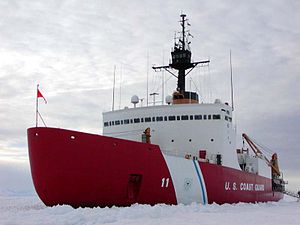USCGC Polar Sea (WAGB-11)
| History | |
|---|---|
|
|
|
| Builder: | Lockheed Shipbuilding and Construction Company, Seattle, WA |
| Commissioned: | 1977 |
| Motto: | Always Summer, Never Warm |
| Nickname(s): | Building 11, Polar Roller, What a Great Boat, Wandering Arctic Garbage Barge, Red Tubs of Fun, We Always Go Bye-Bye |
| Status: | Out of service since 2010 |
| General characteristics | |
| Class and type: | Polar-class icebreaker |
| Displacement: |
|
| Length: | 399 ft (122 m) |
| Beam: | 83 ft 6 in (25.45 m) |
| Draft: | 31 ft (9.4 m) |
| Installed power: |
|
| Propulsion: |
|
| Speed: |
|
| Range: |
|
| Complement: |
|
| Aircraft carried: | 2 HH-65C Dolphin helicopters |
USCGC Polar Sea (WAGB-11) is a United States Coast Guard Heavy Icebreaker. Commissioned in 1977, the ship was built by Lockheed Shipbuilding and Construction Company of Seattle along with her sister ship, Polar Star (WAGB-10). Her home port is Seattle, Washington.
Polar Sea has been out of service since 2010 due to complete failure of five of her six Alco main diesel engines. Examination of her engines indicated excessive engine wear, with engine pistons welded to their sleeves. A root cause analysis apparently traced the problem to improper installation of piston rings and/or installation of incorrect (chromed vs. plain) rings. In 2011 the Coast Guard slated Polar Sea for demolition in 2012, but the scrapping of the 35-year-old icebreaker was postponed by Congress for at least six months in June. A congressional authorization required the Coast Guard to make a report to Congress on the feasibility of retrofitting Polar Sea. The report was submitted in November 2013 and indicated that it is feasible to retrofit and reactivate Polar Sea. As of 25 February 2015 the laid up ship was still in limbo alongside a pier at the Coast Guard Station on Elliott Bay, Seattle. It has not been determined if a new class may be funded, commercial icebreaker leasing options will be explored, and/or if the ship should be scrapped.
Polar Sea uses four different methods of electronic navigation to overcome the difficulties of high-latitude operations, and a computerized propulsion control system to effectively manage six diesel-powered propulsion generators, three diesel-powered ship's service generators, three propulsion gas turbines, and other equipment vital to the operation of the ship. The extensive use of automation and low maintenance materials have greatly reduced staffing requirements.
Polar Sea's three shafts are each turned by either a two diesel-electric or one gas turbine power plants. Each shaft is connected to a 16-foot (4.9-m) diameter, four-bladed, controllable-pitch propeller. For all three shafts, the diesel-electric plants can produce a total of 18,000 shaft horsepower (13,425 kilowatts) and the gas turbine plants a total of 75,000 demand shaft horsepower (56 MW) or 60,000 continuous horsepower (44.8 MW).
...
Wikipedia

